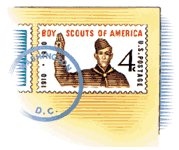![]() March-April 2001
March-April 2001

I saw a picture in the magazine of Webelos Scouts in canoes with their parents. Have the Safe Scouting rules changed to allow Webelos Scouts in canoes?
Curt Eidem
Everett, Wash.
According to the BSA statement of Safety Afloat standards (BSA Supply No. 34368B), "Canoeing, kayaking, and rafting for Cub Scouts (including Webelos Scouts) is to be limited to council/district events on flat water ponds or controlled lake areas free of powerboats and sailboats. Prior to recreational canoeing and kayaking, Cub Scouts are to be instructed in basic handling skills and safety practices."
I enjoyed the account in the October The Way It Was column about President Warren G. Harding's final journey. [In addition to the places mentioned in the article] President Harding also made a tremendous impression in Seattle when he stopped for a brief visit while returning from Alaska during his fateful crosscountry trip. On July 27, 1923, he addressed a large boys' picnic in the city's Woodland Park. Many Scouts were in attendance.
In the aftermath of Harding's death, a large concrete memorial was constructed in 1925 in the park near the city zoo. It featured a life-sized bas relief of the President speaking to the boys during his visit.
The memorial featured two life-size bronze statues of Scouts in uniform, standing at attention and giving the Scout sign. They were the work of a Seattle sculptor, Alice Robertson Carr.
Several decades later, the memorial was torn down for zoo expansion. Fortunately, the two Scout statues were given to the Chief Seattle Council, and today they stand in the foyer of the council service center. (The statues appear to be portraits of two actual Scouts. We hope to discover the names of the two boys who have been "immortalized in bronze.")
Today, the statues have a significance far beyond their original purpose. They represent the loyalty and patriotism that has characterized the Spirit of Scouting throughout the decades.
Rev. Michael Bruce Johnson
Seattle, Wash.
I enjoyed the suggestions in the October 2000 Front Line Stuff column on ways to make a pack's annual blue and gold banquet special. As the chairman of several banquets over the years, I have found the following idea to be successful and one the boys really enjoy.
I write letters of invitation to various political leaders in December or early January—from the queen of England (where Scouting originated) to our local mayor (and we have actually had the mayor attend as the guest of honor).
The letters of regret are framed and read aloud during the dinner. We then award them to the Cub Scouts as door prizes.
Richard Becker
Assistant Scoutmaster, Troop 493
Virginia Beach, Va.
September 2000's The Way It Was column, "Camping—By the Book," quoted Morris Slotkin of Troop 26, Brooklyn, N.Y., and noted that he joined the Boy Scouts in 1926.
I was a Scout in that troop in the late 1940s, when "Slot" came back from the service after the war and picked up the leadership of the troop as Scoutmaster.
I was about 14 or 15 years old in those days, and [even though] after a short time with the troop he moved to the Midwest, I remember him with a great deal of affection. He inspired all of us, and [was] one of the most wonderful men I ever knew.
Troop 26 received its original charter in September 1910 and is one of the oldest Scout units in the United States. The troop is still operating in the Williamsburg neighborhood in Brooklyn and our Troop 26 Alumni Association supports it with funds for outdoor equipment. We also operate the Arnold Solomon Memorial Fund, which provides a campership to send a boy to summer camp each year. The fund is named in memory of our friend, Arnold, whom we lost in the Korean War.
Alan Yanofsky
Chairman, Jewish Committee on Scouting
Theodore Roosevelt Council
Nassau County, N.Y.
In October our Eagle Scout son, Ryan Emond, arrived at the Amundsen-Scott South Pole Station in Antarctica to begin his new 13-month job. He is serving as environmental, health, and safety coordinator for Raytheon Polar Service Co.'s construction of a new facility for housing personnel and science experimentation.
He will gladly answer any questions sent to him from leaders, Boy Scouts, Cub Scouts, and school classrooms. For more information, see his Web site: http://www.geocities.com/rmemond/index.html or e-mail him at rmemond@hotmail.com.
Alice Marie Slaven-Emond
Eagle Scout Mother
Farmington, N.M.
In an e-mail message from Antarctica, Ryan Emond told Scouting magazine about his boyhood Scouting experiences: "I started Scouting in 1982 ... I still remember racing into the house in Lewistown, Mont., clutching a flier inviting boys to join Cub Scout Pack 301. I received my Eagle Scout Award in August 1992, [and] the values and skills I learned in Scouting have been an underlying platform to help me get to the places I am at today."
Our pack has a pretty complete Web site, http://www.pack773.org. I started it about two years ago, and it's turned into the place to go to get more info for all members.
I am pretty fond of it, and it seems to be a winner for visitors.
Rick Harpenau
Pack 773
Tequesta, Fla.
Copyright © 2001 by the Boy Scouts of America. All rights thereunder reserved; anything appearing in Scouting magazine or on its Web site may not be reprinted either wholly or in part without written permission. Because of freedom given authors, opinions may not reflect official concurrence.
| The Boy Scouts of America | http://www.scouting.org |